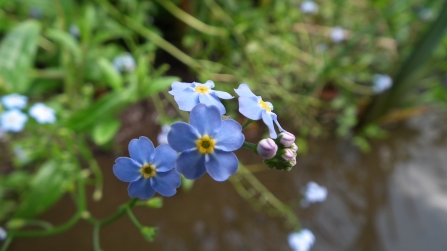The sun pokes out from behind a dark ominous cloud, shedding beams of warmth onto the stream edge. There in the shallows, an inconspicuous but beautiful blaze of azure blue lights up in this early morning scene. I linger a moment breathing in the moisture laden dewy air, the distant sound of crows 'croaking' call and the gentle trickle of water over a chalky gravel bed before me. A minnow darts across my eye-line, taking refuge under the life keeping blanket of blue flowers in front of me and my gaze returns to the reflected blue, studded with yellow eyes, staring back at me.
'Vergisz mein nicht'...
Water forget-me-not © Scott Petrek

Water forget-me-not © Jon Traill
This jolt of life, in an otherwise dull and damp morning, reminded me of the wonderful legendary folk tale behind the naming of this wetland gem of a flower:
In medieval Germany a knight in shining armour, out walking with his one true love on a riverside walk, leant down to pick a bunch of flowers and in the process lost his footing and fell headlong into the water. The weight of the armour dragged him down and as he took his last breath he threw the flower posy up to his beloved, crying out 'vergisz mein nicht'.
The French romanticised the tale of this flower further, by not only naming it 'ne m'oubliez pas' but also with the shorter and sweeter 'aimez moi'.
It wasn't until 1802 when Samuel Taylor Coleridge wrote his poem 'The Keepsake', based around the incident of the drowning knight, that the English translation took hold.
....Nor can I find, amid my lonely walk
By rivulet, or spring, or wet roadside
That blue and bright eyed flowerlet of the brook,
Hope's gentle gem, the sweet Forget-me-not

